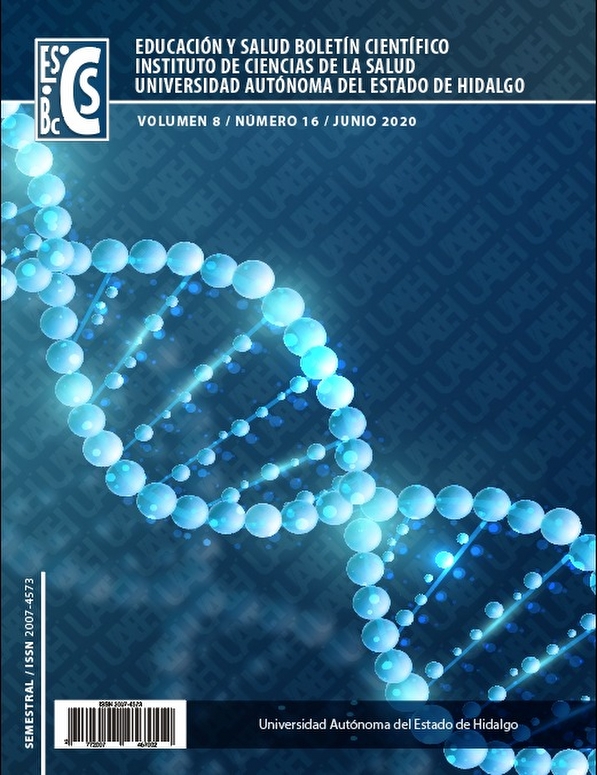Prevalence of retained canines in patients who attend ICSa
Abstract
Introduction: Retained teeth are those that are partially or fully developed and housed inside the jaws. Different studies mention that canines, after third molars, show a higher prevalence in presenting retention. Justification: The canine is considered an important dental organ for shaping the facial massif. The correct position helps the contour and aesthetic appearance of the face, its loss will lead to facial alteration, deficiency in the development of the dental arch and inadequate occlusion. No studies have been found in the state of Hidalgo on the behavior of this dental organ, therefore, the following questioning is an important reason. What is the prevalence of retained permanent canines and damage to adjacent teeth on 250 panoramic and cephalic radiographs of patients who attend dental care at the orthodontics clinics of AAO ICSa? Objective: To determine the prevalence of canines retained in the upper jaw and alterations caused to adjacent dental organs. Methodology: Descriptive cross-sectional study in 250 panoramic and cephalic radiographs of patients from 8 to 25 years of age. Results: 250 panoramic and cephalic were drawn, 153 (61.2%) were female and 97 (38.8%) male. The prevalence of retained canines was 62.6% (n = 313). 15.6% (n = 78) presented a dilated root shape and curve that represents an unfavorable risk of eruption, 14.8% (n = 74) presented a mesioangular position and 1% (n = 5) in a mesiohorizontal position. The damage to adjacent dental organs was 6.6% (n = 33), with the most affected being the lateral incisor with 4% (n = 20). Conclusions: Timely detection of canine rash will allow preventive or interceptive diagnosis and treatment avoiding damage to adjacent teeth, improving patient occlusion and facial aesthetics.
Downloads
References
Aguana, Cohen K, Padrón L. Diagnóstico de caninos retenidos y su importancia en el tratamiento ortodóncico. Revista Latinoamericana de Ortodoncia y Odontopediatría. 2011.
De Rapaport H, Aichembaum A. Caninos retenidos. Revista Ateneo Argentino de Odontologia (RAAO). 2007; 46(2):10-16.
Escoda C, Berini L. Dientes incluidos. Causas de la inclusión dentaria. Posibilidades terapéuticas ante una inclusión dentaria. Tratado de cirugía bucal. Ergon. 2015;335-337.
Castañeda DA, Briceño CR, Sánchez AE, Rodríguez A, Castro D, Bareientos S. Prevalencia de dientes incluidos, retenidos e impactados analizados en radiografías panorámicas de la población de Bogotá, Colombia. Univ Odontol. 2015;34(73):149-157.
Martínez IP, Vera ME, Mora R. Manejo ortodóncico de paciente con desplazamiento de canino asociado a una inusual impactación del incisivo superior. Reporte de caso. Revista Mexicana de Ortodoncia. 2014;2(1):57-66.
Ugalde FJ, González R. Prevalencia de retenciones de caninos en pacientes tratados en la clínica de ortodoncia de UNITEC. Revista de la Asociación Dental Mexicana. 1999;56(2):49-58.
Egido S, Arnau S, Juárez I, Jané E, Marí A, López J. Caninos incluidos, tratamiento odontológico. Revisión de la literatura. Avances en Odontoestomatologia. 2013;29(5):227-238.
Canut Brusola JA. Ortodoncia clínica y terapéutica. Elsevier Masson. 2010:60-61
Ugalde FJ. Clasificación de caninos retenidos y su aplicación clínica. Revista de la Asociación Dental Mexicana. 2001;58(1):21-30.
Cooke J, Wang H. Canine impactions: incidence and management. Int. Journal Periodontics Restorative Dent. 2006;26(5):483-491.
Guere I, Silva R. Evaluación radiográfica de caninos maxilares impactados, en una muestra de una población mexicana. Revista Latinoamericana de Ortodoncia y Odontopediatría, 2013:34-37.
Khadija S, Zouheir I, Kehoum E. Means of localization of impacted canines: new update. Belge Med Dent. 2010;65(2):87-96.
Martínez A, Diaz A, Fonseca M. Enfoque quirúrgico de canino incluido en el paladar: Reporte de un caso y revisión de la literatura. Revista de la Facultad de Ciencias de la Salud. 2009;6(1):56-61.
Pentón V, Véliz Z, Herrera L. Diente retenido-invertido. Presentación de un caso: modelos de diagnóstico y evaluación. Revista Científica de las Ciencias Médicas en Cienfuegos. 2009;7(6):59-63
Pérez MA, Pérez P, Fierro C. Alteraciones en la erupción de caninos permanentes. International Journal of Morfhology. 2007;27(1):139-143











